Comparing Carillion to Enron: A Corporate Governance Research Essay
VerifiedAdded on 2023/04/11
|22
|5321
|239
Essay
AI Summary
This research essay delves into the Carillion scandal, comparing it to the Enron case and examining the failures in corporate governance that led to its collapse. The essay provides a background of Carillion Plc., highlighting its rapid growth and eventual financial challenges. It explores the key issues, including failures in risk management, financial reporting, and the role of the board of directors. The analysis covers the impact on employees, investors, and suppliers, as well as the role of auditors like KPMG. The essay also examines the mishandling of the pension fund and the lack of transparency. The conclusion emphasizes the importance of good corporate governance and offers insights into the measures needed to prevent similar crises in the future. The essay highlights the lessons learned from Carillion's downfall, emphasizing the need for accountability, transparency, and effective oversight to ensure the sustainability of businesses.

1
Corporate Governance
Name:
Instructor:
Course:
Date:
Corporate governance
Research Essay
“Has the Carillion scandal become the UK's Enron?”
Introduction
Carillion Plc. turned out to be like the UK’s Enron in 2016 after being declared bankrupt
and going down like Enron in 2001 which had also been declared bankrupt due to similar
management lapses. This essay will provide evidence that the Carillion case was similar to UK’s
Enron. It will give the background of Carillion Plc. Corporate governance. To put the Carillion
operations into context, this research paper will highlight the similarities shared with UK’s Enron
which will show how lack of good corporate governance negatively affects businesses. The last
part of this assignment will focus on prudent measure to be taken in ensuring organizations
develop a culture of corporate governance. The ultimate goal is to highlight the positive impacts
of good corporate governance and measures to be taken when corporations are faced with
challenges.
Corporate Governance
Name:
Instructor:
Course:
Date:
Corporate governance
Research Essay
“Has the Carillion scandal become the UK's Enron?”
Introduction
Carillion Plc. turned out to be like the UK’s Enron in 2016 after being declared bankrupt
and going down like Enron in 2001 which had also been declared bankrupt due to similar
management lapses. This essay will provide evidence that the Carillion case was similar to UK’s
Enron. It will give the background of Carillion Plc. Corporate governance. To put the Carillion
operations into context, this research paper will highlight the similarities shared with UK’s Enron
which will show how lack of good corporate governance negatively affects businesses. The last
part of this assignment will focus on prudent measure to be taken in ensuring organizations
develop a culture of corporate governance. The ultimate goal is to highlight the positive impacts
of good corporate governance and measures to be taken when corporations are faced with
challenges.
Paraphrase This Document
Need a fresh take? Get an instant paraphrase of this document with our AI Paraphraser
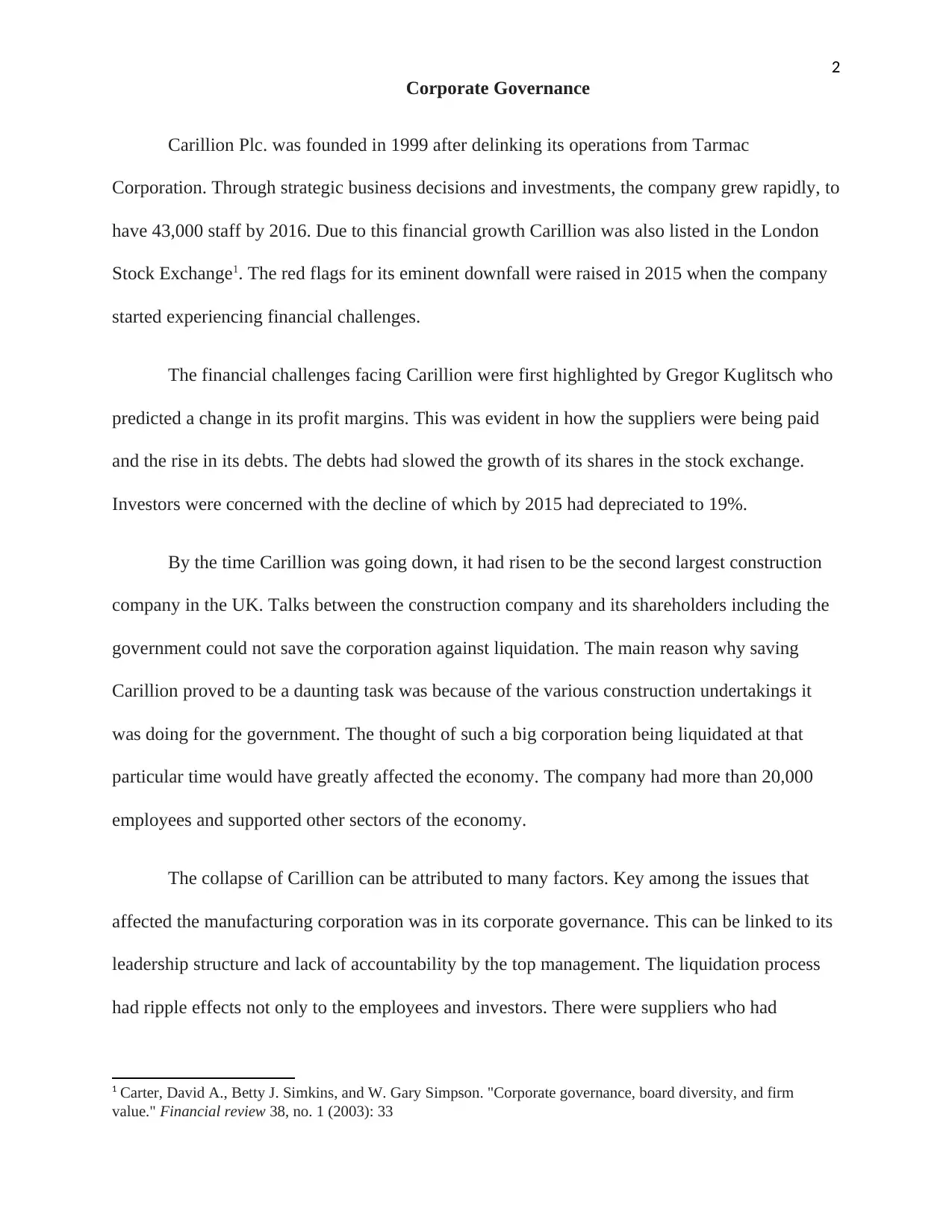
2
Corporate Governance
Carillion Plc. was founded in 1999 after delinking its operations from Tarmac
Corporation. Through strategic business decisions and investments, the company grew rapidly, to
have 43,000 staff by 2016. Due to this financial growth Carillion was also listed in the London
Stock Exchange1. The red flags for its eminent downfall were raised in 2015 when the company
started experiencing financial challenges.
The financial challenges facing Carillion were first highlighted by Gregor Kuglitsch who
predicted a change in its profit margins. This was evident in how the suppliers were being paid
and the rise in its debts. The debts had slowed the growth of its shares in the stock exchange.
Investors were concerned with the decline of which by 2015 had depreciated to 19%.
By the time Carillion was going down, it had risen to be the second largest construction
company in the UK. Talks between the construction company and its shareholders including the
government could not save the corporation against liquidation. The main reason why saving
Carillion proved to be a daunting task was because of the various construction undertakings it
was doing for the government. The thought of such a big corporation being liquidated at that
particular time would have greatly affected the economy. The company had more than 20,000
employees and supported other sectors of the economy.
The collapse of Carillion can be attributed to many factors. Key among the issues that
affected the manufacturing corporation was in its corporate governance. This can be linked to its
leadership structure and lack of accountability by the top management. The liquidation process
had ripple effects not only to the employees and investors. There were suppliers who had
1 Carter, David A., Betty J. Simkins, and W. Gary Simpson. "Corporate governance, board diversity, and firm
value." Financial review 38, no. 1 (2003): 33
Corporate Governance
Carillion Plc. was founded in 1999 after delinking its operations from Tarmac
Corporation. Through strategic business decisions and investments, the company grew rapidly, to
have 43,000 staff by 2016. Due to this financial growth Carillion was also listed in the London
Stock Exchange1. The red flags for its eminent downfall were raised in 2015 when the company
started experiencing financial challenges.
The financial challenges facing Carillion were first highlighted by Gregor Kuglitsch who
predicted a change in its profit margins. This was evident in how the suppliers were being paid
and the rise in its debts. The debts had slowed the growth of its shares in the stock exchange.
Investors were concerned with the decline of which by 2015 had depreciated to 19%.
By the time Carillion was going down, it had risen to be the second largest construction
company in the UK. Talks between the construction company and its shareholders including the
government could not save the corporation against liquidation. The main reason why saving
Carillion proved to be a daunting task was because of the various construction undertakings it
was doing for the government. The thought of such a big corporation being liquidated at that
particular time would have greatly affected the economy. The company had more than 20,000
employees and supported other sectors of the economy.
The collapse of Carillion can be attributed to many factors. Key among the issues that
affected the manufacturing corporation was in its corporate governance. This can be linked to its
leadership structure and lack of accountability by the top management. The liquidation process
had ripple effects not only to the employees and investors. There were suppliers who had
1 Carter, David A., Betty J. Simkins, and W. Gary Simpson. "Corporate governance, board diversity, and firm
value." Financial review 38, no. 1 (2003): 33
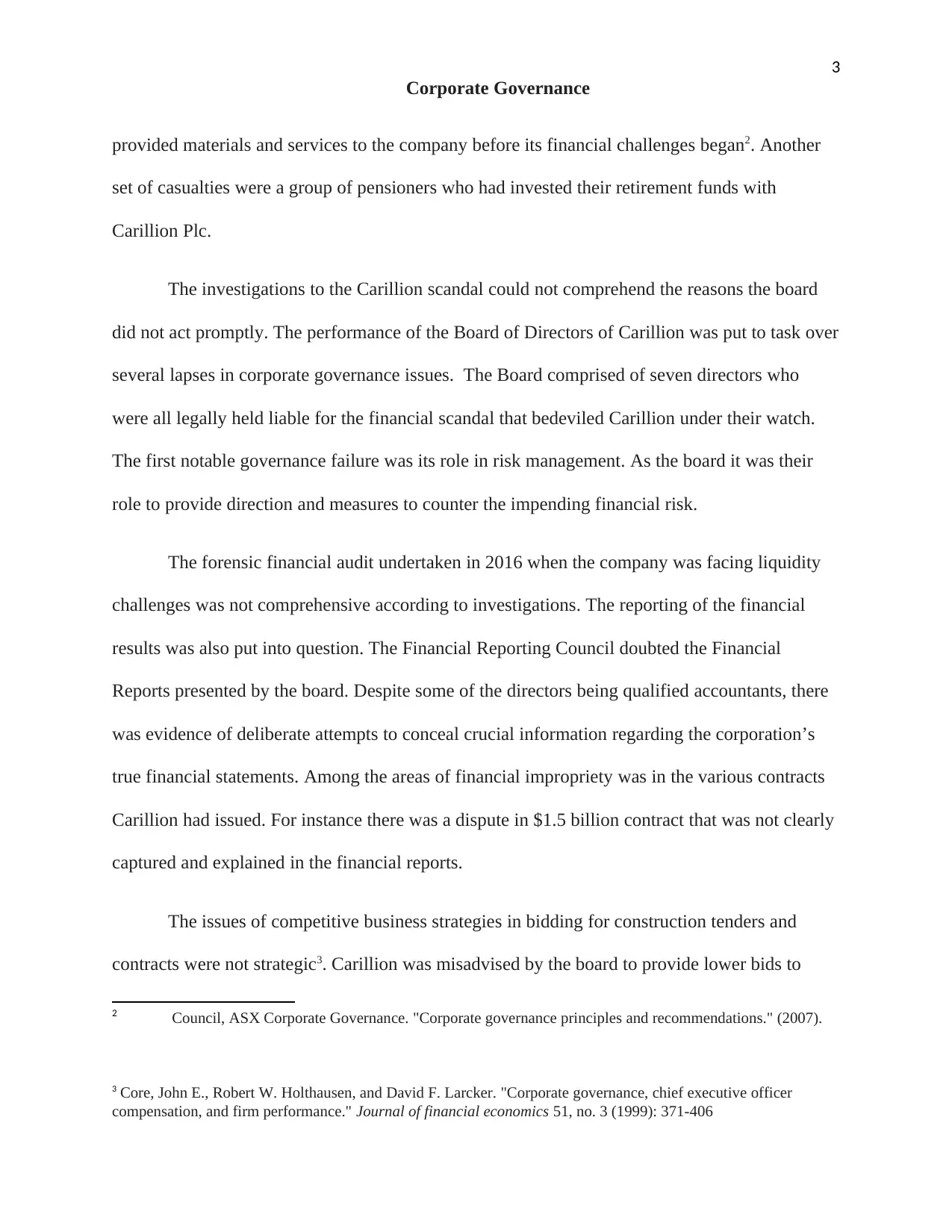
3
Corporate Governance
provided materials and services to the company before its financial challenges began2. Another
set of casualties were a group of pensioners who had invested their retirement funds with
Carillion Plc.
The investigations to the Carillion scandal could not comprehend the reasons the board
did not act promptly. The performance of the Board of Directors of Carillion was put to task over
several lapses in corporate governance issues. The Board comprised of seven directors who
were all legally held liable for the financial scandal that bedeviled Carillion under their watch.
The first notable governance failure was its role in risk management. As the board it was their
role to provide direction and measures to counter the impending financial risk.
The forensic financial audit undertaken in 2016 when the company was facing liquidity
challenges was not comprehensive according to investigations. The reporting of the financial
results was also put into question. The Financial Reporting Council doubted the Financial
Reports presented by the board. Despite some of the directors being qualified accountants, there
was evidence of deliberate attempts to conceal crucial information regarding the corporation’s
true financial statements. Among the areas of financial impropriety was in the various contracts
Carillion had issued. For instance there was a dispute in $1.5 billion contract that was not clearly
captured and explained in the financial reports.
The issues of competitive business strategies in bidding for construction tenders and
contracts were not strategic3. Carillion was misadvised by the board to provide lower bids to
2 Council, ASX Corporate Governance. "Corporate governance principles and recommendations." (2007).
3 Core, John E., Robert W. Holthausen, and David F. Larcker. "Corporate governance, chief executive officer
compensation, and firm performance." Journal of financial economics 51, no. 3 (1999): 371-406
Corporate Governance
provided materials and services to the company before its financial challenges began2. Another
set of casualties were a group of pensioners who had invested their retirement funds with
Carillion Plc.
The investigations to the Carillion scandal could not comprehend the reasons the board
did not act promptly. The performance of the Board of Directors of Carillion was put to task over
several lapses in corporate governance issues. The Board comprised of seven directors who
were all legally held liable for the financial scandal that bedeviled Carillion under their watch.
The first notable governance failure was its role in risk management. As the board it was their
role to provide direction and measures to counter the impending financial risk.
The forensic financial audit undertaken in 2016 when the company was facing liquidity
challenges was not comprehensive according to investigations. The reporting of the financial
results was also put into question. The Financial Reporting Council doubted the Financial
Reports presented by the board. Despite some of the directors being qualified accountants, there
was evidence of deliberate attempts to conceal crucial information regarding the corporation’s
true financial statements. Among the areas of financial impropriety was in the various contracts
Carillion had issued. For instance there was a dispute in $1.5 billion contract that was not clearly
captured and explained in the financial reports.
The issues of competitive business strategies in bidding for construction tenders and
contracts were not strategic3. Carillion was misadvised by the board to provide lower bids to
2 Council, ASX Corporate Governance. "Corporate governance principles and recommendations." (2007).
3 Core, John E., Robert W. Holthausen, and David F. Larcker. "Corporate governance, chief executive officer
compensation, and firm performance." Journal of financial economics 51, no. 3 (1999): 371-406
⊘ This is a preview!⊘
Do you want full access?
Subscribe today to unlock all pages.

Trusted by 1+ million students worldwide

4
Corporate Governance
wins lucrative tenders. This was to help them beat other contractors when it came to pricing.
Although their prices were competitive, the manufacturing company found it difficult to deliver
in its contracts. The board should have priced the bidding processes in way that could not be
straining leading to cash flow challenges.
The failure by the board of directors to clearly pin point financial misappropriation can be
solely attributed to two of its directors who were accountants. Unfortunately this is not the case.
The other directors were also held legally liable for negligence. Relying on only the two directors
who were accounts to provide the financial statements was no defense to the other directors.
Prudent corporate governance dictates that all the directors are responsible for the sustainability
of the business. There are very many viable options for non-financial directors to get basic
financial skills for interpretation and scrutinizing financial reports. Some of this includes
executive programs and corporate training for directors.
The 3rd of May 2017 Annual General Meeting held by Carillion was not effective in
communicating its financial position to the stakeholders. Prior to the AGM there was sufficient
evidence to the challenges that Carillion was facing. The AGM provided a very good opportunity
for management to convey the right position of the company to the stakeholders which they did
not. The shareholders could have come up with resolutions and measures to address the
liquidation challenges faced4. It was unfortunate for the company to issue profit warning exactly
four weeks after the AGM.
The profit warning announcement prompted the Financial Conduct Agency to launch
investigations against Carillion based on the timeliness. The reasoning behind the timelines in
4 Daily, Catherine M., Dan R. Dalton, and Albert A. Cannella Jr. "Corporate governance: Decades of dialogue and
data." Academy of management review 28, no. 3 (2003): 371-382
Corporate Governance
wins lucrative tenders. This was to help them beat other contractors when it came to pricing.
Although their prices were competitive, the manufacturing company found it difficult to deliver
in its contracts. The board should have priced the bidding processes in way that could not be
straining leading to cash flow challenges.
The failure by the board of directors to clearly pin point financial misappropriation can be
solely attributed to two of its directors who were accountants. Unfortunately this is not the case.
The other directors were also held legally liable for negligence. Relying on only the two directors
who were accounts to provide the financial statements was no defense to the other directors.
Prudent corporate governance dictates that all the directors are responsible for the sustainability
of the business. There are very many viable options for non-financial directors to get basic
financial skills for interpretation and scrutinizing financial reports. Some of this includes
executive programs and corporate training for directors.
The 3rd of May 2017 Annual General Meeting held by Carillion was not effective in
communicating its financial position to the stakeholders. Prior to the AGM there was sufficient
evidence to the challenges that Carillion was facing. The AGM provided a very good opportunity
for management to convey the right position of the company to the stakeholders which they did
not. The shareholders could have come up with resolutions and measures to address the
liquidation challenges faced4. It was unfortunate for the company to issue profit warning exactly
four weeks after the AGM.
The profit warning announcement prompted the Financial Conduct Agency to launch
investigations against Carillion based on the timeliness. The reasoning behind the timelines in
4 Daily, Catherine M., Dan R. Dalton, and Albert A. Cannella Jr. "Corporate governance: Decades of dialogue and
data." Academy of management review 28, no. 3 (2003): 371-382
Paraphrase This Document
Need a fresh take? Get an instant paraphrase of this document with our AI Paraphraser
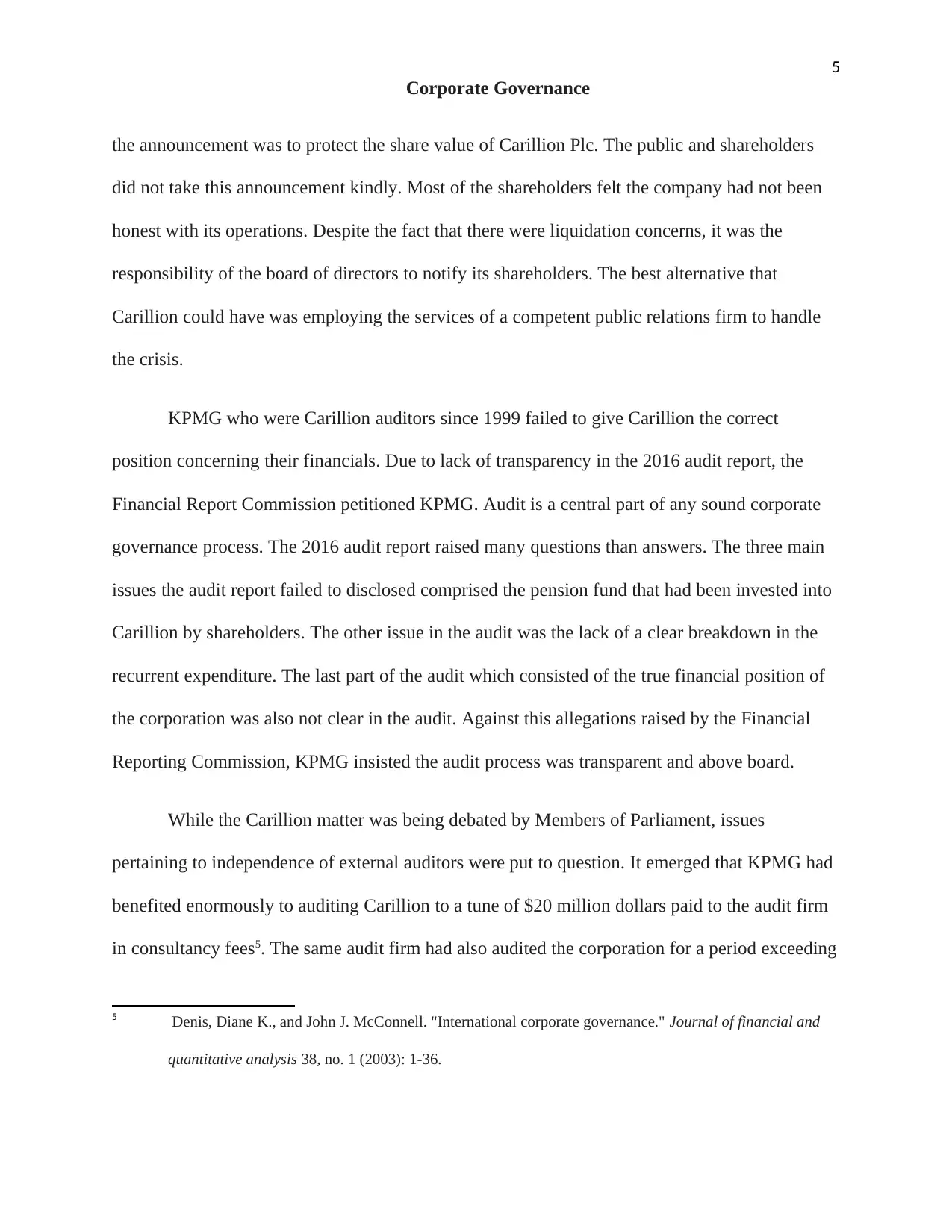
5
Corporate Governance
the announcement was to protect the share value of Carillion Plc. The public and shareholders
did not take this announcement kindly. Most of the shareholders felt the company had not been
honest with its operations. Despite the fact that there were liquidation concerns, it was the
responsibility of the board of directors to notify its shareholders. The best alternative that
Carillion could have was employing the services of a competent public relations firm to handle
the crisis.
KPMG who were Carillion auditors since 1999 failed to give Carillion the correct
position concerning their financials. Due to lack of transparency in the 2016 audit report, the
Financial Report Commission petitioned KPMG. Audit is a central part of any sound corporate
governance process. The 2016 audit report raised many questions than answers. The three main
issues the audit report failed to disclosed comprised the pension fund that had been invested into
Carillion by shareholders. The other issue in the audit was the lack of a clear breakdown in the
recurrent expenditure. The last part of the audit which consisted of the true financial position of
the corporation was also not clear in the audit. Against this allegations raised by the Financial
Reporting Commission, KPMG insisted the audit process was transparent and above board.
While the Carillion matter was being debated by Members of Parliament, issues
pertaining to independence of external auditors were put to question. It emerged that KPMG had
benefited enormously to auditing Carillion to a tune of $20 million dollars paid to the audit firm
in consultancy fees5. The same audit firm had also audited the corporation for a period exceeding
5 Denis, Diane K., and John J. McConnell. "International corporate governance." Journal of financial and
quantitative analysis 38, no. 1 (2003): 1-36.
Corporate Governance
the announcement was to protect the share value of Carillion Plc. The public and shareholders
did not take this announcement kindly. Most of the shareholders felt the company had not been
honest with its operations. Despite the fact that there were liquidation concerns, it was the
responsibility of the board of directors to notify its shareholders. The best alternative that
Carillion could have was employing the services of a competent public relations firm to handle
the crisis.
KPMG who were Carillion auditors since 1999 failed to give Carillion the correct
position concerning their financials. Due to lack of transparency in the 2016 audit report, the
Financial Report Commission petitioned KPMG. Audit is a central part of any sound corporate
governance process. The 2016 audit report raised many questions than answers. The three main
issues the audit report failed to disclosed comprised the pension fund that had been invested into
Carillion by shareholders. The other issue in the audit was the lack of a clear breakdown in the
recurrent expenditure. The last part of the audit which consisted of the true financial position of
the corporation was also not clear in the audit. Against this allegations raised by the Financial
Reporting Commission, KPMG insisted the audit process was transparent and above board.
While the Carillion matter was being debated by Members of Parliament, issues
pertaining to independence of external auditors were put to question. It emerged that KPMG had
benefited enormously to auditing Carillion to a tune of $20 million dollars paid to the audit firm
in consultancy fees5. The same audit firm had also audited the corporation for a period exceeding
5 Denis, Diane K., and John J. McConnell. "International corporate governance." Journal of financial and
quantitative analysis 38, no. 1 (2003): 1-36.
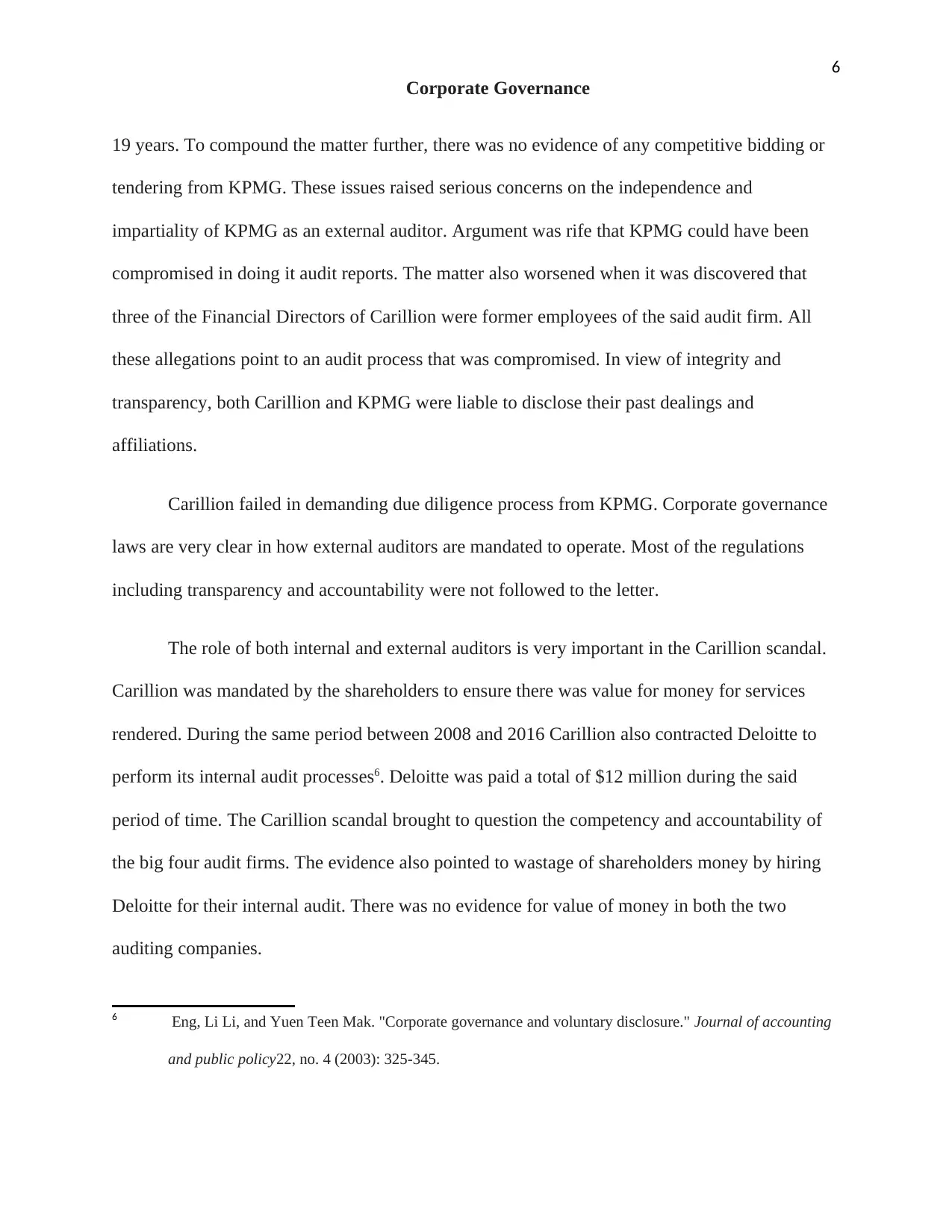
6
Corporate Governance
19 years. To compound the matter further, there was no evidence of any competitive bidding or
tendering from KPMG. These issues raised serious concerns on the independence and
impartiality of KPMG as an external auditor. Argument was rife that KPMG could have been
compromised in doing it audit reports. The matter also worsened when it was discovered that
three of the Financial Directors of Carillion were former employees of the said audit firm. All
these allegations point to an audit process that was compromised. In view of integrity and
transparency, both Carillion and KPMG were liable to disclose their past dealings and
affiliations.
Carillion failed in demanding due diligence process from KPMG. Corporate governance
laws are very clear in how external auditors are mandated to operate. Most of the regulations
including transparency and accountability were not followed to the letter.
The role of both internal and external auditors is very important in the Carillion scandal.
Carillion was mandated by the shareholders to ensure there was value for money for services
rendered. During the same period between 2008 and 2016 Carillion also contracted Deloitte to
perform its internal audit processes6. Deloitte was paid a total of $12 million during the said
period of time. The Carillion scandal brought to question the competency and accountability of
the big four audit firms. The evidence also pointed to wastage of shareholders money by hiring
Deloitte for their internal audit. There was no evidence for value of money in both the two
auditing companies.
6 Eng, Li Li, and Yuen Teen Mak. "Corporate governance and voluntary disclosure." Journal of accounting
and public policy22, no. 4 (2003): 325-345.
Corporate Governance
19 years. To compound the matter further, there was no evidence of any competitive bidding or
tendering from KPMG. These issues raised serious concerns on the independence and
impartiality of KPMG as an external auditor. Argument was rife that KPMG could have been
compromised in doing it audit reports. The matter also worsened when it was discovered that
three of the Financial Directors of Carillion were former employees of the said audit firm. All
these allegations point to an audit process that was compromised. In view of integrity and
transparency, both Carillion and KPMG were liable to disclose their past dealings and
affiliations.
Carillion failed in demanding due diligence process from KPMG. Corporate governance
laws are very clear in how external auditors are mandated to operate. Most of the regulations
including transparency and accountability were not followed to the letter.
The role of both internal and external auditors is very important in the Carillion scandal.
Carillion was mandated by the shareholders to ensure there was value for money for services
rendered. During the same period between 2008 and 2016 Carillion also contracted Deloitte to
perform its internal audit processes6. Deloitte was paid a total of $12 million during the said
period of time. The Carillion scandal brought to question the competency and accountability of
the big four audit firms. The evidence also pointed to wastage of shareholders money by hiring
Deloitte for their internal audit. There was no evidence for value of money in both the two
auditing companies.
6 Eng, Li Li, and Yuen Teen Mak. "Corporate governance and voluntary disclosure." Journal of accounting
and public policy22, no. 4 (2003): 325-345.
⊘ This is a preview!⊘
Do you want full access?
Subscribe today to unlock all pages.

Trusted by 1+ million students worldwide
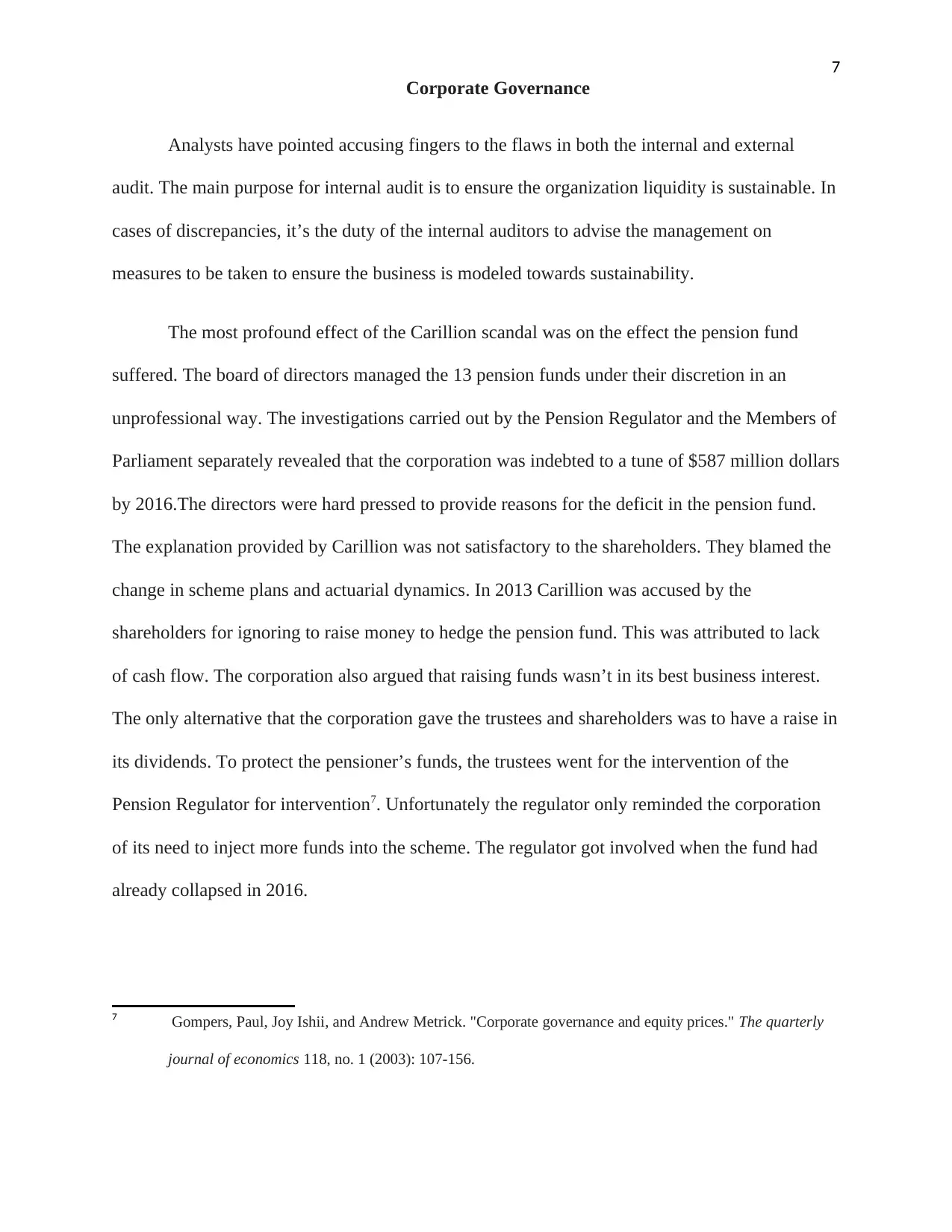
7
Corporate Governance
Analysts have pointed accusing fingers to the flaws in both the internal and external
audit. The main purpose for internal audit is to ensure the organization liquidity is sustainable. In
cases of discrepancies, it’s the duty of the internal auditors to advise the management on
measures to be taken to ensure the business is modeled towards sustainability.
The most profound effect of the Carillion scandal was on the effect the pension fund
suffered. The board of directors managed the 13 pension funds under their discretion in an
unprofessional way. The investigations carried out by the Pension Regulator and the Members of
Parliament separately revealed that the corporation was indebted to a tune of $587 million dollars
by 2016.The directors were hard pressed to provide reasons for the deficit in the pension fund.
The explanation provided by Carillion was not satisfactory to the shareholders. They blamed the
change in scheme plans and actuarial dynamics. In 2013 Carillion was accused by the
shareholders for ignoring to raise money to hedge the pension fund. This was attributed to lack
of cash flow. The corporation also argued that raising funds wasn’t in its best business interest.
The only alternative that the corporation gave the trustees and shareholders was to have a raise in
its dividends. To protect the pensioner’s funds, the trustees went for the intervention of the
Pension Regulator for intervention7. Unfortunately the regulator only reminded the corporation
of its need to inject more funds into the scheme. The regulator got involved when the fund had
already collapsed in 2016.
7 Gompers, Paul, Joy Ishii, and Andrew Metrick. "Corporate governance and equity prices." The quarterly
journal of economics 118, no. 1 (2003): 107-156.
Corporate Governance
Analysts have pointed accusing fingers to the flaws in both the internal and external
audit. The main purpose for internal audit is to ensure the organization liquidity is sustainable. In
cases of discrepancies, it’s the duty of the internal auditors to advise the management on
measures to be taken to ensure the business is modeled towards sustainability.
The most profound effect of the Carillion scandal was on the effect the pension fund
suffered. The board of directors managed the 13 pension funds under their discretion in an
unprofessional way. The investigations carried out by the Pension Regulator and the Members of
Parliament separately revealed that the corporation was indebted to a tune of $587 million dollars
by 2016.The directors were hard pressed to provide reasons for the deficit in the pension fund.
The explanation provided by Carillion was not satisfactory to the shareholders. They blamed the
change in scheme plans and actuarial dynamics. In 2013 Carillion was accused by the
shareholders for ignoring to raise money to hedge the pension fund. This was attributed to lack
of cash flow. The corporation also argued that raising funds wasn’t in its best business interest.
The only alternative that the corporation gave the trustees and shareholders was to have a raise in
its dividends. To protect the pensioner’s funds, the trustees went for the intervention of the
Pension Regulator for intervention7. Unfortunately the regulator only reminded the corporation
of its need to inject more funds into the scheme. The regulator got involved when the fund had
already collapsed in 2016.
7 Gompers, Paul, Joy Ishii, and Andrew Metrick. "Corporate governance and equity prices." The quarterly
journal of economics 118, no. 1 (2003): 107-156.
Paraphrase This Document
Need a fresh take? Get an instant paraphrase of this document with our AI Paraphraser
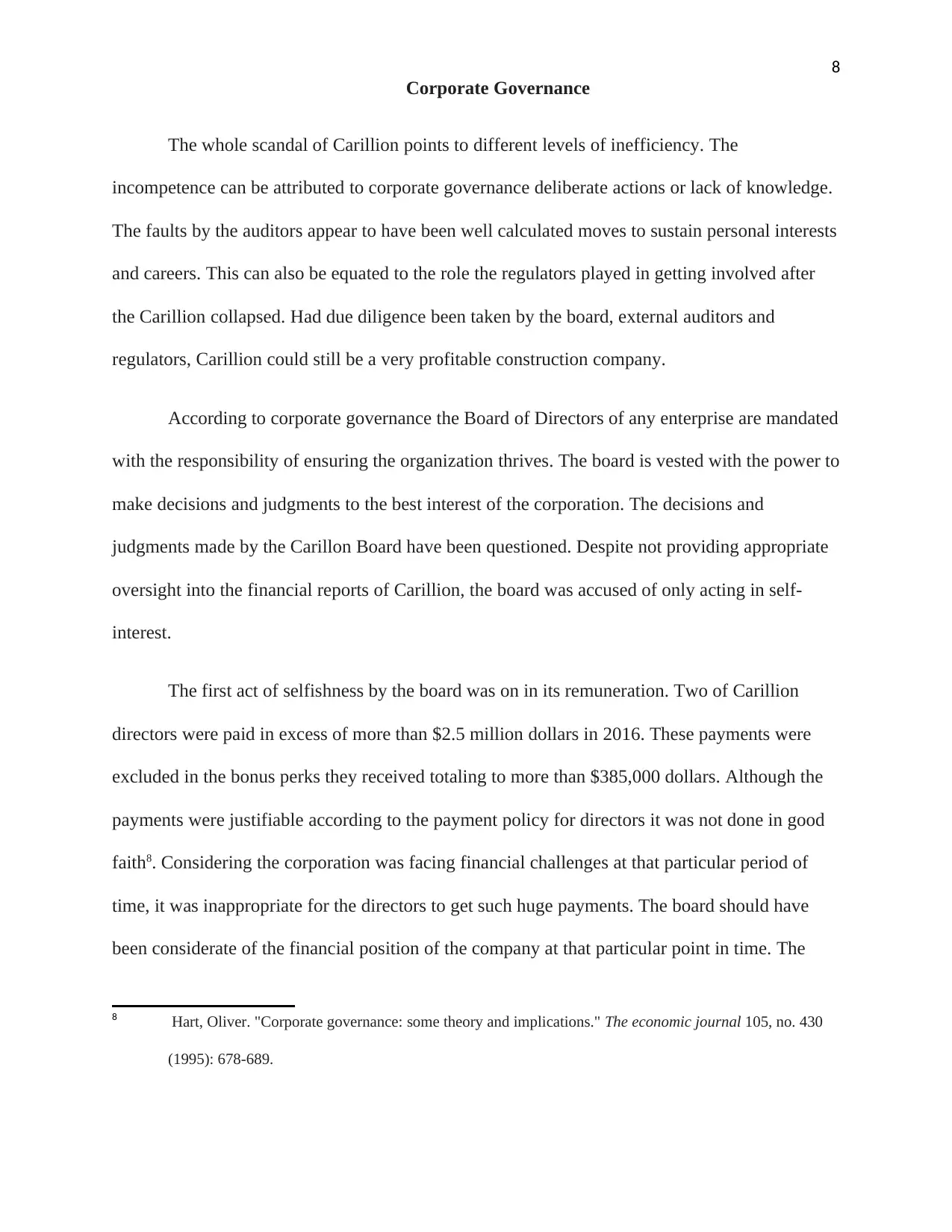
8
Corporate Governance
The whole scandal of Carillion points to different levels of inefficiency. The
incompetence can be attributed to corporate governance deliberate actions or lack of knowledge.
The faults by the auditors appear to have been well calculated moves to sustain personal interests
and careers. This can also be equated to the role the regulators played in getting involved after
the Carillion collapsed. Had due diligence been taken by the board, external auditors and
regulators, Carillion could still be a very profitable construction company.
According to corporate governance the Board of Directors of any enterprise are mandated
with the responsibility of ensuring the organization thrives. The board is vested with the power to
make decisions and judgments to the best interest of the corporation. The decisions and
judgments made by the Carillon Board have been questioned. Despite not providing appropriate
oversight into the financial reports of Carillion, the board was accused of only acting in self-
interest.
The first act of selfishness by the board was on in its remuneration. Two of Carillion
directors were paid in excess of more than $2.5 million dollars in 2016. These payments were
excluded in the bonus perks they received totaling to more than $385,000 dollars. Although the
payments were justifiable according to the payment policy for directors it was not done in good
faith8. Considering the corporation was facing financial challenges at that particular period of
time, it was inappropriate for the directors to get such huge payments. The board should have
been considerate of the financial position of the company at that particular point in time. The
8 Hart, Oliver. "Corporate governance: some theory and implications." The economic journal 105, no. 430
(1995): 678-689.
Corporate Governance
The whole scandal of Carillion points to different levels of inefficiency. The
incompetence can be attributed to corporate governance deliberate actions or lack of knowledge.
The faults by the auditors appear to have been well calculated moves to sustain personal interests
and careers. This can also be equated to the role the regulators played in getting involved after
the Carillion collapsed. Had due diligence been taken by the board, external auditors and
regulators, Carillion could still be a very profitable construction company.
According to corporate governance the Board of Directors of any enterprise are mandated
with the responsibility of ensuring the organization thrives. The board is vested with the power to
make decisions and judgments to the best interest of the corporation. The decisions and
judgments made by the Carillon Board have been questioned. Despite not providing appropriate
oversight into the financial reports of Carillion, the board was accused of only acting in self-
interest.
The first act of selfishness by the board was on in its remuneration. Two of Carillion
directors were paid in excess of more than $2.5 million dollars in 2016. These payments were
excluded in the bonus perks they received totaling to more than $385,000 dollars. Although the
payments were justifiable according to the payment policy for directors it was not done in good
faith8. Considering the corporation was facing financial challenges at that particular period of
time, it was inappropriate for the directors to get such huge payments. The board should have
been considerate of the financial position of the company at that particular point in time. The
8 Hart, Oliver. "Corporate governance: some theory and implications." The economic journal 105, no. 430
(1995): 678-689.
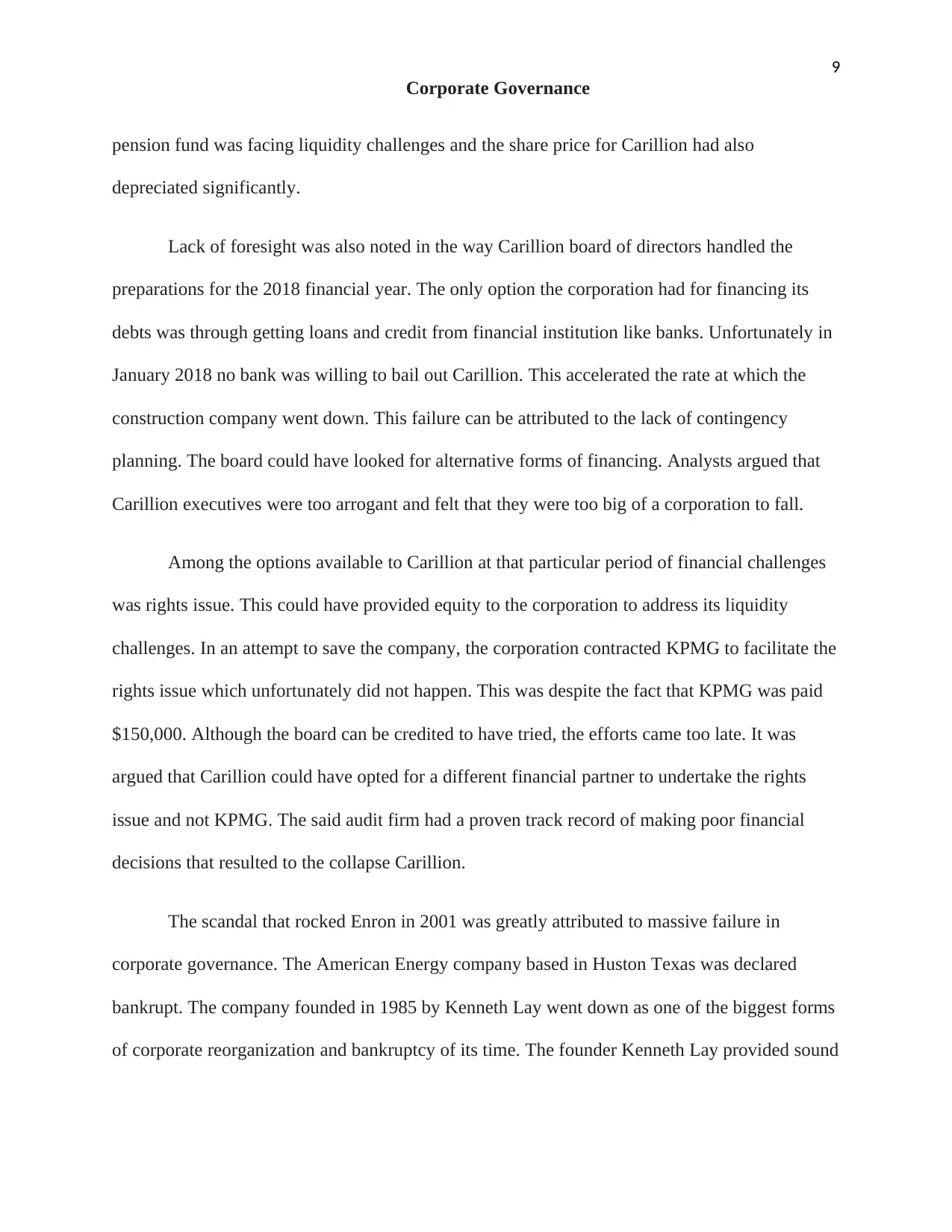
9
Corporate Governance
pension fund was facing liquidity challenges and the share price for Carillion had also
depreciated significantly.
Lack of foresight was also noted in the way Carillion board of directors handled the
preparations for the 2018 financial year. The only option the corporation had for financing its
debts was through getting loans and credit from financial institution like banks. Unfortunately in
January 2018 no bank was willing to bail out Carillion. This accelerated the rate at which the
construction company went down. This failure can be attributed to the lack of contingency
planning. The board could have looked for alternative forms of financing. Analysts argued that
Carillion executives were too arrogant and felt that they were too big of a corporation to fall.
Among the options available to Carillion at that particular period of financial challenges
was rights issue. This could have provided equity to the corporation to address its liquidity
challenges. In an attempt to save the company, the corporation contracted KPMG to facilitate the
rights issue which unfortunately did not happen. This was despite the fact that KPMG was paid
$150,000. Although the board can be credited to have tried, the efforts came too late. It was
argued that Carillion could have opted for a different financial partner to undertake the rights
issue and not KPMG. The said audit firm had a proven track record of making poor financial
decisions that resulted to the collapse Carillion.
The scandal that rocked Enron in 2001 was greatly attributed to massive failure in
corporate governance. The American Energy company based in Huston Texas was declared
bankrupt. The company founded in 1985 by Kenneth Lay went down as one of the biggest forms
of corporate reorganization and bankruptcy of its time. The founder Kenneth Lay provided sound
Corporate Governance
pension fund was facing liquidity challenges and the share price for Carillion had also
depreciated significantly.
Lack of foresight was also noted in the way Carillion board of directors handled the
preparations for the 2018 financial year. The only option the corporation had for financing its
debts was through getting loans and credit from financial institution like banks. Unfortunately in
January 2018 no bank was willing to bail out Carillion. This accelerated the rate at which the
construction company went down. This failure can be attributed to the lack of contingency
planning. The board could have looked for alternative forms of financing. Analysts argued that
Carillion executives were too arrogant and felt that they were too big of a corporation to fall.
Among the options available to Carillion at that particular period of financial challenges
was rights issue. This could have provided equity to the corporation to address its liquidity
challenges. In an attempt to save the company, the corporation contracted KPMG to facilitate the
rights issue which unfortunately did not happen. This was despite the fact that KPMG was paid
$150,000. Although the board can be credited to have tried, the efforts came too late. It was
argued that Carillion could have opted for a different financial partner to undertake the rights
issue and not KPMG. The said audit firm had a proven track record of making poor financial
decisions that resulted to the collapse Carillion.
The scandal that rocked Enron in 2001 was greatly attributed to massive failure in
corporate governance. The American Energy company based in Huston Texas was declared
bankrupt. The company founded in 1985 by Kenneth Lay went down as one of the biggest forms
of corporate reorganization and bankruptcy of its time. The founder Kenneth Lay provided sound
⊘ This is a preview!⊘
Do you want full access?
Subscribe today to unlock all pages.

Trusted by 1+ million students worldwide
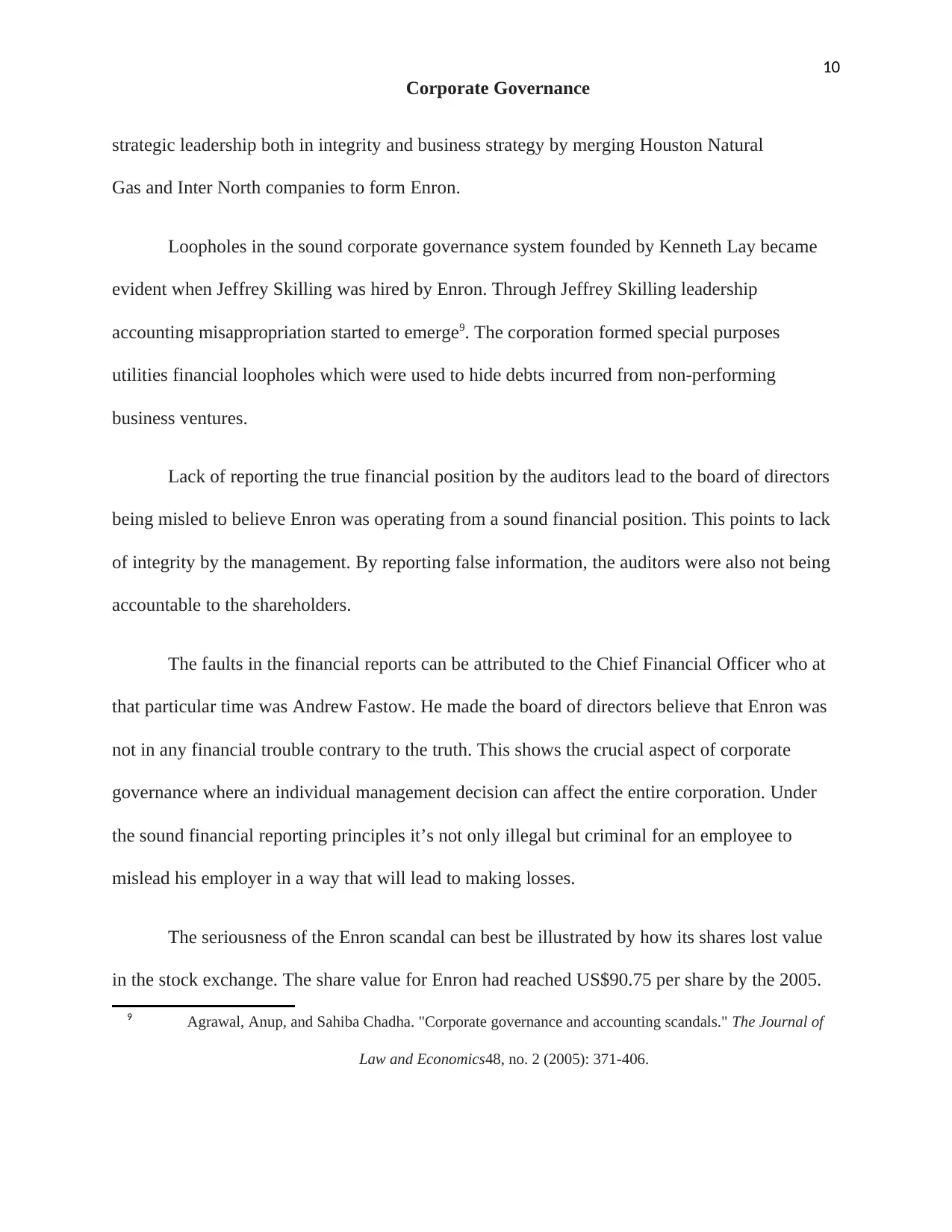
10
Corporate Governance
strategic leadership both in integrity and business strategy by merging Houston Natural
Gas and Inter North companies to form Enron.
Loopholes in the sound corporate governance system founded by Kenneth Lay became
evident when Jeffrey Skilling was hired by Enron. Through Jeffrey Skilling leadership
accounting misappropriation started to emerge9. The corporation formed special purposes
utilities financial loopholes which were used to hide debts incurred from non-performing
business ventures.
Lack of reporting the true financial position by the auditors lead to the board of directors
being misled to believe Enron was operating from a sound financial position. This points to lack
of integrity by the management. By reporting false information, the auditors were also not being
accountable to the shareholders.
The faults in the financial reports can be attributed to the Chief Financial Officer who at
that particular time was Andrew Fastow. He made the board of directors believe that Enron was
not in any financial trouble contrary to the truth. This shows the crucial aspect of corporate
governance where an individual management decision can affect the entire corporation. Under
the sound financial reporting principles it’s not only illegal but criminal for an employee to
mislead his employer in a way that will lead to making losses.
The seriousness of the Enron scandal can best be illustrated by how its shares lost value
in the stock exchange. The share value for Enron had reached US$90.75 per share by the 2005.
9 Agrawal, Anup, and Sahiba Chadha. "Corporate governance and accounting scandals." The Journal of
Law and Economics48, no. 2 (2005): 371-406.
Corporate Governance
strategic leadership both in integrity and business strategy by merging Houston Natural
Gas and Inter North companies to form Enron.
Loopholes in the sound corporate governance system founded by Kenneth Lay became
evident when Jeffrey Skilling was hired by Enron. Through Jeffrey Skilling leadership
accounting misappropriation started to emerge9. The corporation formed special purposes
utilities financial loopholes which were used to hide debts incurred from non-performing
business ventures.
Lack of reporting the true financial position by the auditors lead to the board of directors
being misled to believe Enron was operating from a sound financial position. This points to lack
of integrity by the management. By reporting false information, the auditors were also not being
accountable to the shareholders.
The faults in the financial reports can be attributed to the Chief Financial Officer who at
that particular time was Andrew Fastow. He made the board of directors believe that Enron was
not in any financial trouble contrary to the truth. This shows the crucial aspect of corporate
governance where an individual management decision can affect the entire corporation. Under
the sound financial reporting principles it’s not only illegal but criminal for an employee to
mislead his employer in a way that will lead to making losses.
The seriousness of the Enron scandal can best be illustrated by how its shares lost value
in the stock exchange. The share value for Enron had reached US$90.75 per share by the 2005.
9 Agrawal, Anup, and Sahiba Chadha. "Corporate governance and accounting scandals." The Journal of
Law and Economics48, no. 2 (2005): 371-406.
Paraphrase This Document
Need a fresh take? Get an instant paraphrase of this document with our AI Paraphraser
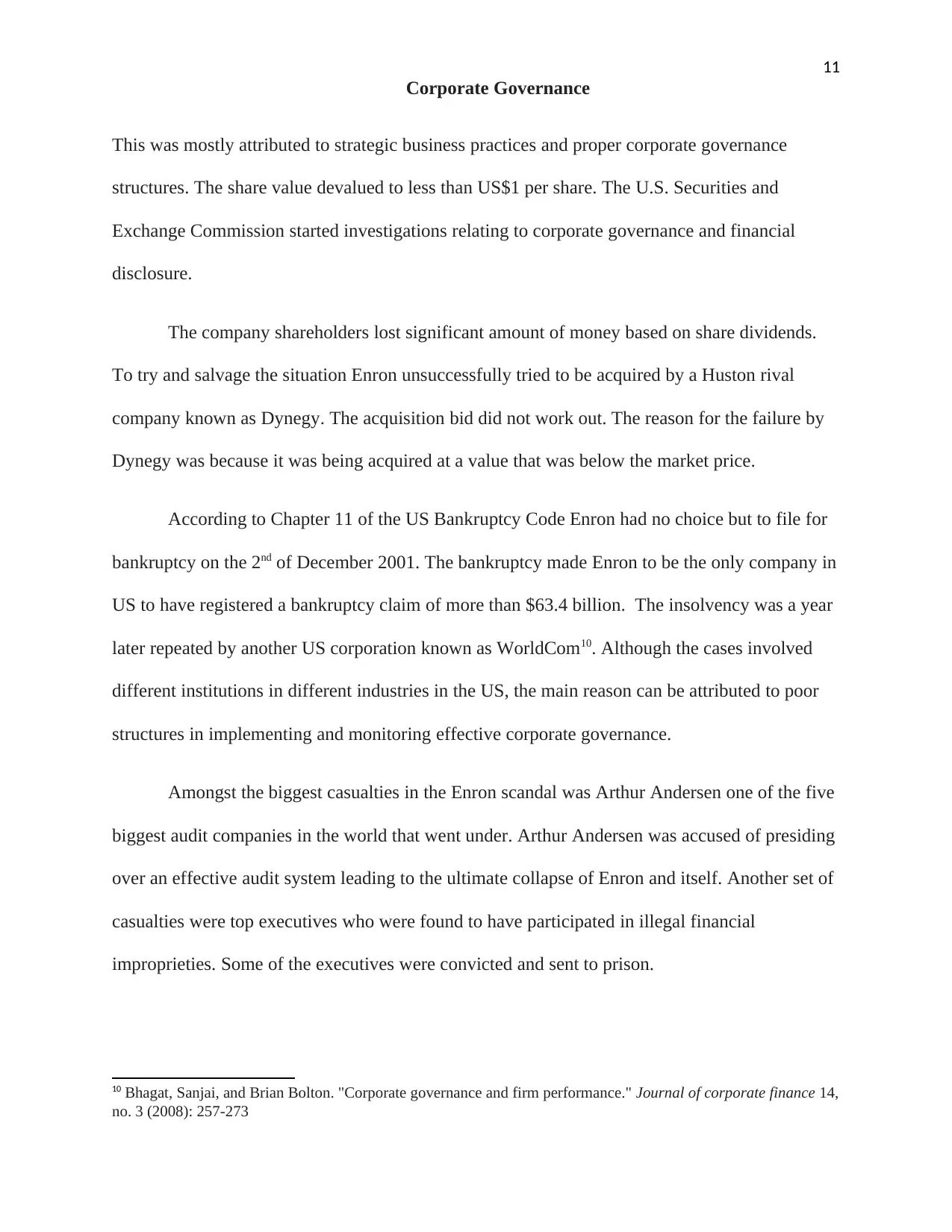
11
Corporate Governance
This was mostly attributed to strategic business practices and proper corporate governance
structures. The share value devalued to less than US$1 per share. The U.S. Securities and
Exchange Commission started investigations relating to corporate governance and financial
disclosure.
The company shareholders lost significant amount of money based on share dividends.
To try and salvage the situation Enron unsuccessfully tried to be acquired by a Huston rival
company known as Dynegy. The acquisition bid did not work out. The reason for the failure by
Dynegy was because it was being acquired at a value that was below the market price.
According to Chapter 11 of the US Bankruptcy Code Enron had no choice but to file for
bankruptcy on the 2nd of December 2001. The bankruptcy made Enron to be the only company in
US to have registered a bankruptcy claim of more than $63.4 billion. The insolvency was a year
later repeated by another US corporation known as WorldCom10. Although the cases involved
different institutions in different industries in the US, the main reason can be attributed to poor
structures in implementing and monitoring effective corporate governance.
Amongst the biggest casualties in the Enron scandal was Arthur Andersen one of the five
biggest audit companies in the world that went under. Arthur Andersen was accused of presiding
over an effective audit system leading to the ultimate collapse of Enron and itself. Another set of
casualties were top executives who were found to have participated in illegal financial
improprieties. Some of the executives were convicted and sent to prison.
10 Bhagat, Sanjai, and Brian Bolton. "Corporate governance and firm performance." Journal of corporate finance 14,
no. 3 (2008): 257-273
Corporate Governance
This was mostly attributed to strategic business practices and proper corporate governance
structures. The share value devalued to less than US$1 per share. The U.S. Securities and
Exchange Commission started investigations relating to corporate governance and financial
disclosure.
The company shareholders lost significant amount of money based on share dividends.
To try and salvage the situation Enron unsuccessfully tried to be acquired by a Huston rival
company known as Dynegy. The acquisition bid did not work out. The reason for the failure by
Dynegy was because it was being acquired at a value that was below the market price.
According to Chapter 11 of the US Bankruptcy Code Enron had no choice but to file for
bankruptcy on the 2nd of December 2001. The bankruptcy made Enron to be the only company in
US to have registered a bankruptcy claim of more than $63.4 billion. The insolvency was a year
later repeated by another US corporation known as WorldCom10. Although the cases involved
different institutions in different industries in the US, the main reason can be attributed to poor
structures in implementing and monitoring effective corporate governance.
Amongst the biggest casualties in the Enron scandal was Arthur Andersen one of the five
biggest audit companies in the world that went under. Arthur Andersen was accused of presiding
over an effective audit system leading to the ultimate collapse of Enron and itself. Another set of
casualties were top executives who were found to have participated in illegal financial
improprieties. Some of the executives were convicted and sent to prison.
10 Bhagat, Sanjai, and Brian Bolton. "Corporate governance and firm performance." Journal of corporate finance 14,
no. 3 (2008): 257-273
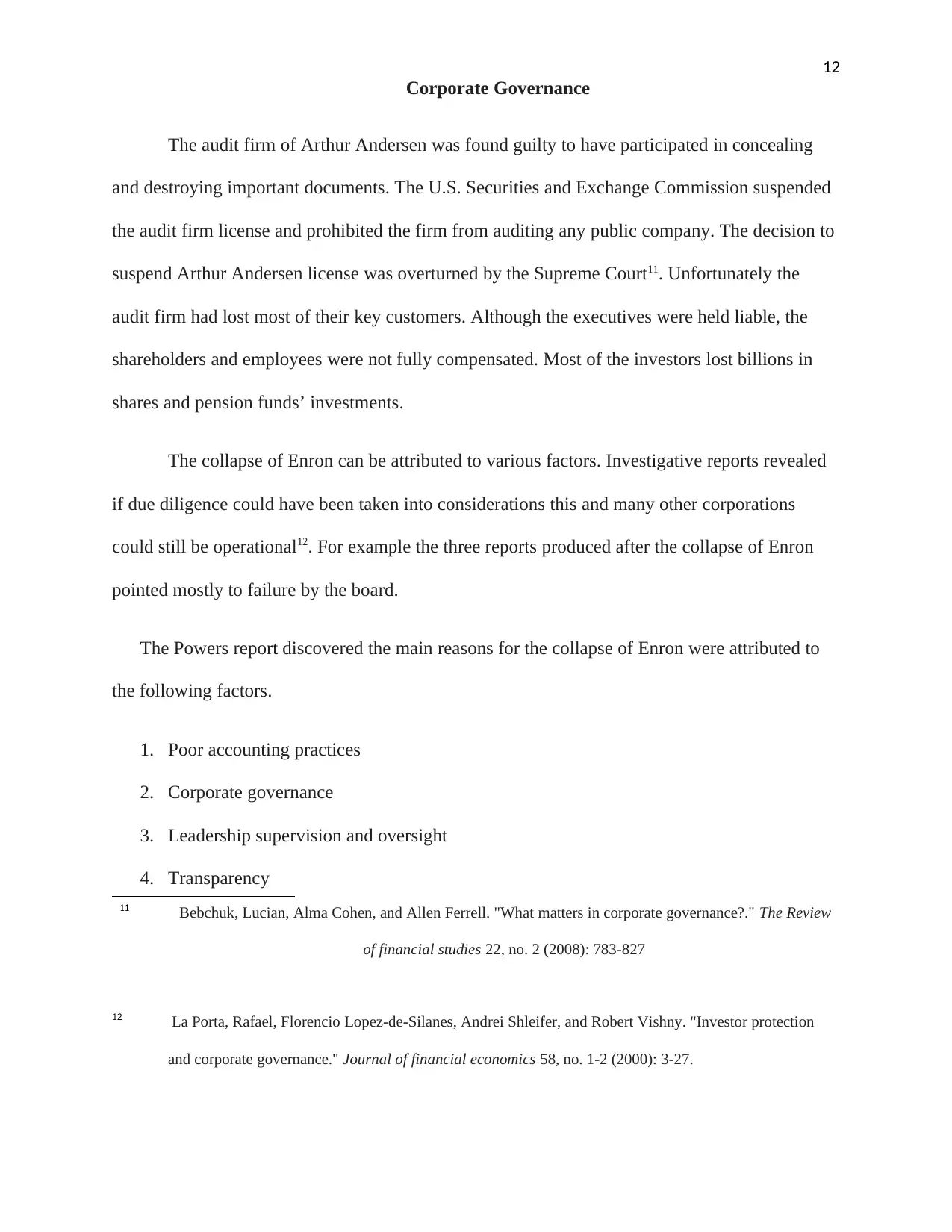
12
Corporate Governance
The audit firm of Arthur Andersen was found guilty to have participated in concealing
and destroying important documents. The U.S. Securities and Exchange Commission suspended
the audit firm license and prohibited the firm from auditing any public company. The decision to
suspend Arthur Andersen license was overturned by the Supreme Court11. Unfortunately the
audit firm had lost most of their key customers. Although the executives were held liable, the
shareholders and employees were not fully compensated. Most of the investors lost billions in
shares and pension funds’ investments.
The collapse of Enron can be attributed to various factors. Investigative reports revealed
if due diligence could have been taken into considerations this and many other corporations
could still be operational12. For example the three reports produced after the collapse of Enron
pointed mostly to failure by the board.
The Powers report discovered the main reasons for the collapse of Enron were attributed to
the following factors.
1. Poor accounting practices
2. Corporate governance
3. Leadership supervision and oversight
4. Transparency
11 Bebchuk, Lucian, Alma Cohen, and Allen Ferrell. "What matters in corporate governance?." The Review
of financial studies 22, no. 2 (2008): 783-827
12 La Porta, Rafael, Florencio Lopez-de-Silanes, Andrei Shleifer, and Robert Vishny. "Investor protection
and corporate governance." Journal of financial economics 58, no. 1-2 (2000): 3-27.
Corporate Governance
The audit firm of Arthur Andersen was found guilty to have participated in concealing
and destroying important documents. The U.S. Securities and Exchange Commission suspended
the audit firm license and prohibited the firm from auditing any public company. The decision to
suspend Arthur Andersen license was overturned by the Supreme Court11. Unfortunately the
audit firm had lost most of their key customers. Although the executives were held liable, the
shareholders and employees were not fully compensated. Most of the investors lost billions in
shares and pension funds’ investments.
The collapse of Enron can be attributed to various factors. Investigative reports revealed
if due diligence could have been taken into considerations this and many other corporations
could still be operational12. For example the three reports produced after the collapse of Enron
pointed mostly to failure by the board.
The Powers report discovered the main reasons for the collapse of Enron were attributed to
the following factors.
1. Poor accounting practices
2. Corporate governance
3. Leadership supervision and oversight
4. Transparency
11 Bebchuk, Lucian, Alma Cohen, and Allen Ferrell. "What matters in corporate governance?." The Review
of financial studies 22, no. 2 (2008): 783-827
12 La Porta, Rafael, Florencio Lopez-de-Silanes, Andrei Shleifer, and Robert Vishny. "Investor protection
and corporate governance." Journal of financial economics 58, no. 1-2 (2000): 3-27.
⊘ This is a preview!⊘
Do you want full access?
Subscribe today to unlock all pages.

Trusted by 1+ million students worldwide
1 out of 22
Related Documents
Your All-in-One AI-Powered Toolkit for Academic Success.
+13062052269
info@desklib.com
Available 24*7 on WhatsApp / Email
![[object Object]](/_next/static/media/star-bottom.7253800d.svg)
Unlock your academic potential
Copyright © 2020–2025 A2Z Services. All Rights Reserved. Developed and managed by ZUCOL.




